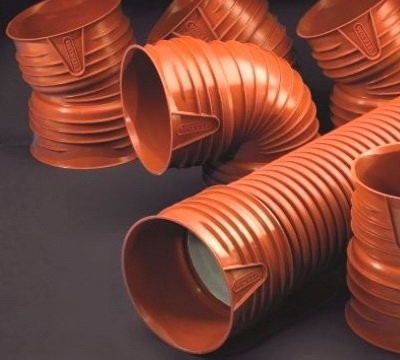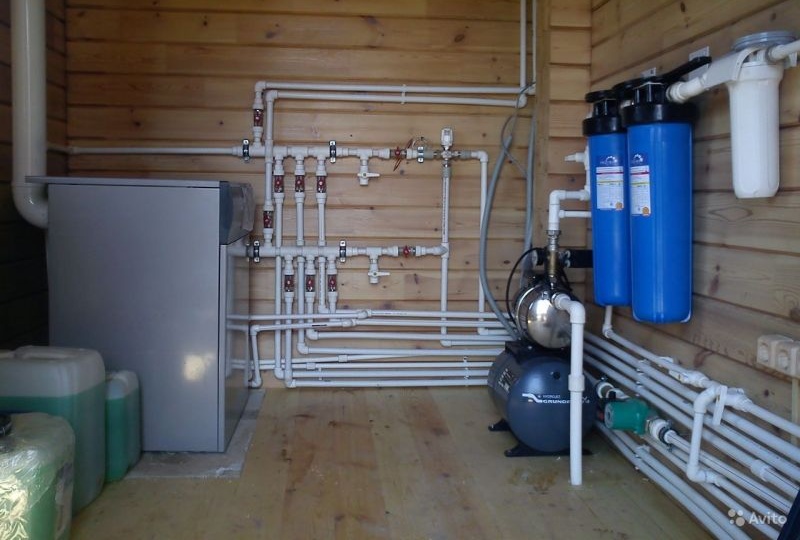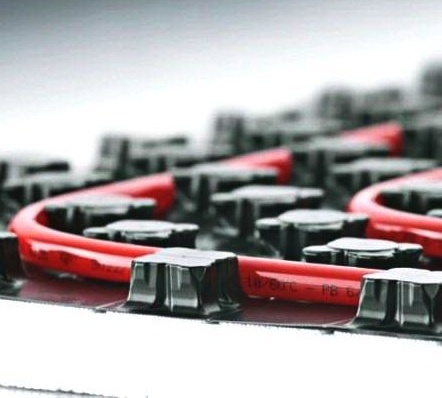What pipes are better to use for the device of the internal sewerage - cast iron or plastic?
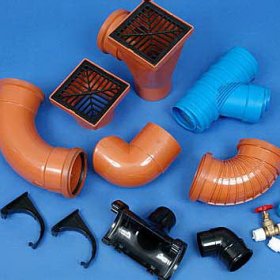
The design of the internal sewage system involves the thorough preparation of each stage of work. One of the most important is the choice of material from which pipes for sewage are made. The wiring project, the installation method, the life of the system, the method of connecting plumbing fixtures and many other nuances depend on the material of the pipes. Even so long ago, the number of options was very small. Whereas today there are much more opportunities. In order to prevent a mistake in the choice, it is worth considering carefully all possible options.
To get a general idea of sewer pipes, we suggest you watch the overview video:
Content
Cast Iron Parts: An Overview of the Pros and Cons
Sewer pipes are made of gray cast iron by centrifugal casting, after which they are processed using cutting tools. The outer and inner surfaces of the elements are coated with a special bitumen composition. It protects the metal from corrosion, and also gives greater surface smoothness, improving pipe throughput. The diameter of the elements varies from 5 to 15 cm, the wall thickness is 10-12 mm. To equip the joints, sockets are provided, the length of which, depending on the diameter of the pipe, can be from 60 to 80 mm.
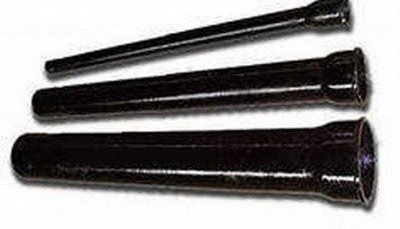
Traditional cast-iron pipes are still widely used for arranging domestic sewers. This is a very reliable, durable and durable option.
Shaped elements are also produced: plugs, fittings and plugs designed to temporarily or permanently block the branches of the pipeline, crosses for branching in the direct direction of the highway, as well as tees or crosses forming various branched configurations of the pipeline. Fittings are used as connecting elements of the sewage system. They are installed on branches, various turns and transitions from one pipe diameter to another. Transition elements are available for working with pipes of different diameters and straight for parts of the same diameter.
The advantages of cast iron parts include:
- High strength and reliability.
- The ability to withstand significant temperature changes, as well as the long-term effects of hot liquids.
- Service life reaching 90-100 years.
- Environmental Safety.
- Resistance to fire.
- Good soundproofing.
You need to know that a long service life is caused by the absence of marriage in the production of pipes: fistulas, sutures, slags present in the anticorrosion coating.Therefore, before installation, it is imperative to check the quality of the products and tap each of them, so you can detect cracks and other hidden defects.
A disadvantage of cast iron products is their heavy weight, which greatly complicates the transportation and installation. Also, the installation of such elements is also quite complicated. It is extremely important to correctly connect the details, the uninterrupted operation of the sewage system depends on this. The most common connection method is considered to be caulking or caulking the gaps between the bell and the shaped part installed in it using a cable. Another drawback of cast-iron drain pipes is the roughness of the inner surface, which contributes to the appearance of deposits. Over time, they can completely block the gap.
Advantages and disadvantages of plastic products
There are several types of plastic pipes.
Option # 1 - PVC pipes
Polyvinyl chloride has been synthesized for a long time, but it has become widely used relatively recently. During the production of pipes, several raw materials are mixed and heated. The result is a plastic homogeneous mass. The composition of the material necessarily includes stabilizers that firmly connect the molecules to each other, and plasticizers that give the plastic certain properties. The preheated mass is molded in a design with predetermined geometric dimensions. There are two types of polyvinyl chloride:
- Plasticized or PVC. It is characterized by increased elasticity, while it has a low strength. Not recommended for pipe production.
- Unplasticized or PVC-U. It has a rigid structure and is highly resistant to various aggressive environments. It is considered one of the best materials for pipes used in domestic sewers.
PVC parts can be connected in different ways. There are two types of connections: socketless and bell-shaped. The first option is used for internal sewage quite rarely. While the second, which can be implemented as a bell-shaped adhesive or mechanical joint, is more popular. The principle of a bell-shaped connection is very simple. A special bell is made at one end of the product; its inner diameter exactly matches the outer of the other product. For additional sealing, a special rubber ring is mounted in the groove. To connect the two elements you just need to insert one into the other.
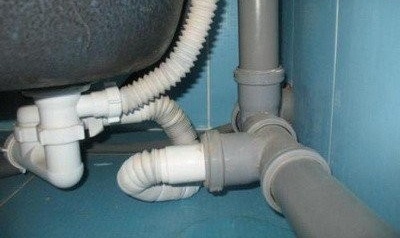
Plastic sewer pipes are gradually replacing traditional cast-iron pipes. They are quite simple to install, reliable and durable.
When choosing which pipes to purchase for domestic sewage, you need to know about the advantages of PVC products:
- Affordable cost, which applies to both pipes and accessories.
- Simple installation. Special tools and special skills are not needed. A hacksaw for metal, a knife and grease will be enough to improve the entry of the element into the socket.
- High mechanical strength.
- Resistance to the adverse effects of ultraviolet radiation.
- The material is not subject to corrosion.
- Polyvinyl chloride is a dielectric. It does not conduct current, so the pipeline does not need grounding.
- A smooth inner surface that prevents the formation of deposits that inhibit runoff.
- Resistance to various hostile environment.
- Long service life, it reaches 50 years.
The disadvantages of the system include low sound insulation and limitations in the temperature regime of operation: from -15 to + 65C. Some products can withstand 90C for a short time. With decreasing temperature, the fragility of the material increases proportionally.
In addition to PVC pipes, the connecting elements necessary for creating an internal sewage system are also produced. They are designed for arranging branches, various turns and transitions to another diameter. On sale you can find:
- Knee.Designed for pipeline turns. The angle of inclination varies from 20 ° to 87 °.
- Reduction. Transitional element for pipes of various diameters.
- Tee. It is used to connect additional highways to the common system and to arrange branches.
- Cross piece. Connects four pipes to a common highway.
In addition to the connecting elements, special parts are also available. These are inspection hatches for inspecting the inner surface of the pipe and a special coupling designed to make the transition from cast iron pipes to PVC.
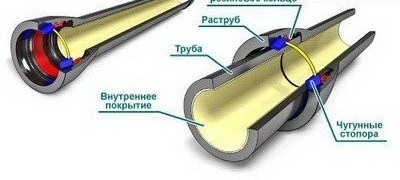
The bell-shaped connection method is very simple. Two parts are inserted one into another and are reliably fixed. A rubber liner in the form of a ring is required to seal
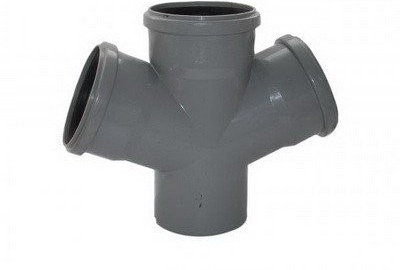
To equip the branches of the sewer line and connect several branches, a special part called a tee is used
Option # 2 - polypropylene pipes
Under the name polypropylene pipes hides a group of products from copolymers and their mixtures. The raw materials from which the parts are made must be indicated on the marking. The best option is the copolymer random 3, it is labeled PPR. For internal sewerage, it is optimal to use products with a diameter of 50 to 110 mm of the PN10 - PN20 brand. Polypropylene pipes for domestic sewage have many advantages:
- Resistance to corrosion, as well as to the formation of deposits.
- High durability providing long service life. It is over 50 years old.
- Light weight. This facilitates transportation and installation.
- A smooth inner surface that provides high throughput.
- Resistance to mechanical influences. Polypropylene is temporarily deformed, without subsequent destruction.
- Chemical inertness, which makes it possible to contact with acids and alkalis.
- No additional protective coating is required.
- The temperature of the transported medium can vary from -50 ° to + 90 °.
For the full arrangement of the pipeline, the corresponding fittings are also produced: compression, flange, self-locking, threaded, etc. The disadvantages of polypropylene include high thermal expansion, which requires the installation of special compensation pipes when installing the system. In addition, the strength characteristics of polypropylene pipes are dependent on the temperature of the effluents. The higher it is, the lower the level of product strength.
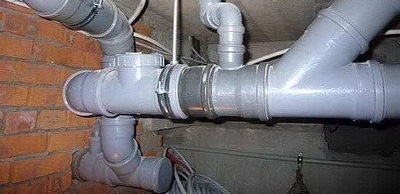
Special fittings allow you to equip the internal sewage system of any, even the most complex, configuration. The main thing is to correctly draw up a diagram
Option # 3 - polyethylene pipes
Polyethylene is formed by the polymerization of ethylene in the presence of catalysts at elevated pressure and temperature. The properties of the obtained material depend on the conditions under which the reaction proceeded. Distinguish:
- High Density Polyethylene or HDPE.
- Low density polyethylene or LDPE.
On sale you can find four types of plastic products:
- LDPE pipes. They are distinguished by resistance to aggressive environments, low weight, as well as reliability and ease of connection.
- HDPE pipes. The most common variant of sewer pipes. Used in areas with cold drains.
- Pressure PE pipes. They are made from PE-80 polymer. They are used in pressure sewer systems.
- Corrugated PE pipes. Quite rarely used for internal sewage, most often mounted for outdoor.
Polyethylene products have many advantages:
- Light weight, which greatly facilitates their installation and transportation.
- Resistance to internal and external chemical influences, as well as corrosion.
- High reliability. There is no need for specialized maintenance of polyethylene sewers.
- Sufficient resistance to possible pressure drops.
- Reasonable price of products.
The disadvantages of the details can be considered insufficiently high abrasion resistance. In polypropylene, it is an order of magnitude higher. As well as low resistance to high temperatures, which limits its use. Connections of polyethylene pipes can be made by bell, socket and welded methods.
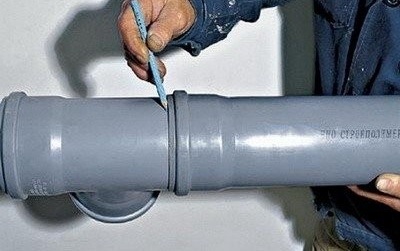
Plastic pipes are very easy to handle. To get the part of the right size, it is enough to mark it and cut it with a regular file
Unambiguously determine which pipe is best used for sewage, only the builder can. To do this, you need to carefully consider all options in relation to specific conditions. All things being equal, experts recommend the use of plastic pipes. Their polypropylene variety. It is these products that concentrate the maximum number of advantages and minimum disadvantages, which guarantees long-term uninterrupted service of the new sewer system.
